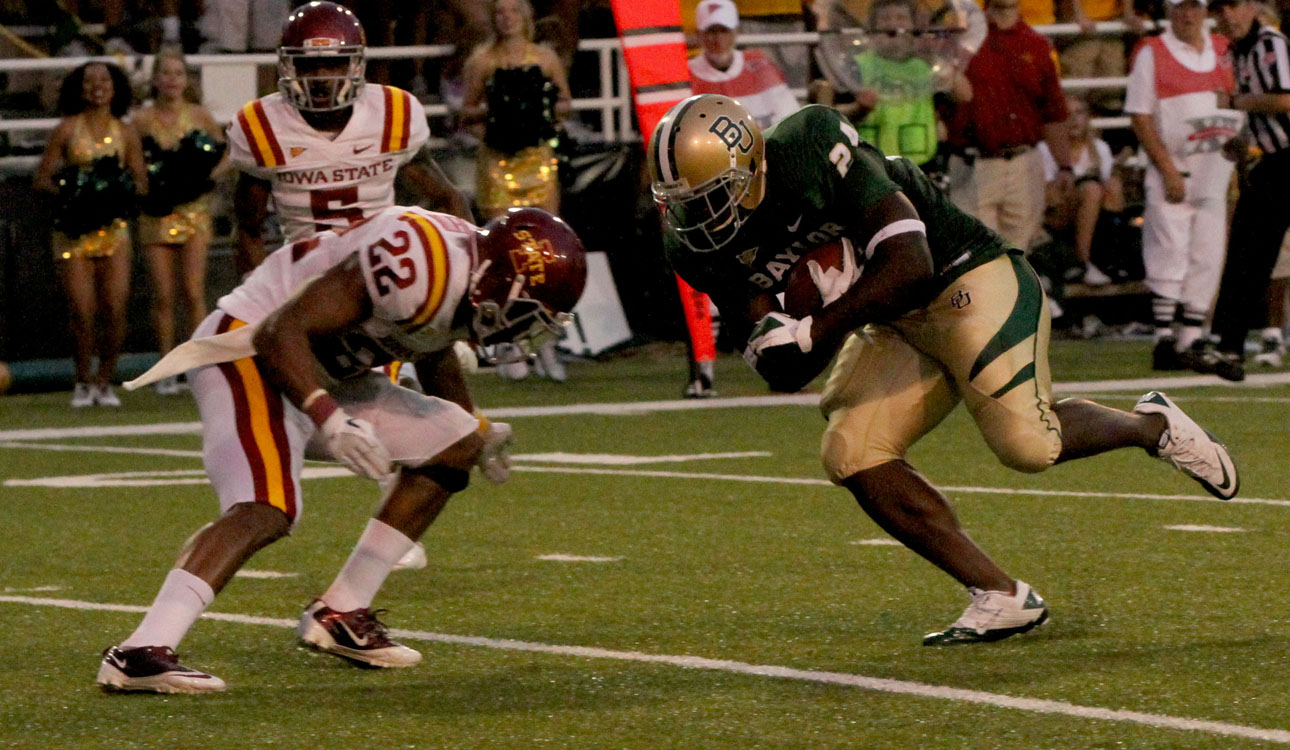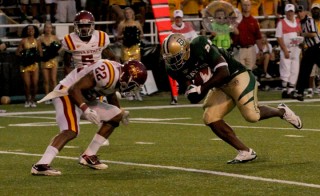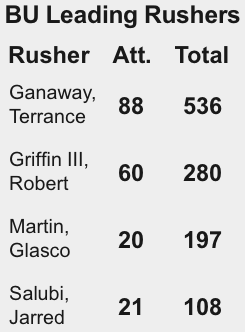

Matthew McCarroll | Lariat Photographer
By Krista Pirtle
Sports Writer
Baylor’s running back corps does not receive much focus with the athletic ability of junior quarterback Robert Griffin III. Praise usually goes to him for game performance week in and week out.
Griffin’s passes have earned him national recognition, with his rare incompletions and only one interception.
This brings attention to the passing game, but the run game has increased in effectiveness as this year has progressed.
At the beginning of the season, there was a question as to who would step up as the leading running back: senior Terrance Ganaway, junior Jarred Salubi or sophomore Glasco Martin.
As Ganaway began to distance himself from the others, Baylor acquired redshirt freshman Lache Seastrunk from Oregon, whose hardship was denied for the 2011 season.
Before the season began, most people in the college football world could correctly assume that the duo of Griffin III and senior wide receiver Kendall Wright would be a force to be reckoned with.
The offensive line has been unstable in the past, leading to the assumption that Baylor’s offense was one-dimensional; however, in 2011, the five on the front line have more than answered the call, providing both time in the pocket for Griffin III and huge holes to run through for the running backs.
Last week against Iowa State, senior running back Terrance Ganaway ran for 200 yards and three touchdowns.
“It was good to see our team do that,” Griffin said. “[Iowa State] took away the pass; they were pretty determined to do that. It wasn’t just that they had great cover guys. They were dropping everybody into coverage. And whenever you have a team that does that, they’re giving up the run. And our offensive line manned up and said, ‘All right, put it on our backs and we’ll take it’ and they took it all the way.”
For 2011 as a whole, Ganaway leads the group of backs with 536 yards and six touchdowns.
When the offense looks to mix it up, either Salubi or Martin go in.
“Those guys are great, great athletes,” Ganaway said. “They have great practices; they know their stuff, so when the ball’s in their hand, they don’t have any choice but to produce. It doesn’t matter who we’re playing. As long as those guys are playing, they’re going to be okay.”
Salubi has 104 yards and a touchdown while Martin has 197 yards and 2 touchdowns.
Entering conference play, head coach Art Briles said he saw the potential of these three and knew work still had to be done.
“We feel like, as we develop more within this season, that our running game will become a little more diverse than it has been the first three weeks,” Briles said. “So that’s something that we’re working on. [Terrance Ganaway, Jarred Salubi and Glasco Martin] did a good job Saturday.”
Sometimes the backs do not even get the ball with such a diverse quarterback in Griffin, who has 280 rush yards and a pair of touchdowns for the season.
“The thing that really gives us a great opportunity when people play us like this is that we have a multi-dimensional quarterback,” Briles said. “We all know what Robert (Griffin III) can do throwing the football, but we also all know what he can do running the football. So we have another threat back there that can really stretch the defense and open up holes for the running backs and allow him to make some runs.”
With such a threat to the secondary in the pass game and the growing dominance of the run game, the Bears offense is more than RG3.
“You really can see how effective the running game is and how (the passing and running games) complement each other,” Ganaway said. “In the [TCU] game, we did two or three plays running, and then there’s a touchdown. Two or three plays running, then there’s a 20-yard pass. It works.”
Ganaway also said a better running game helps the strategy of the offense.
“When you’re passing and you’re spreading out the secondary, and the linebackers got to play outside of the box a little bit, then you’ve got light running boxes and that’s when you get 20-yard gains,” Ganaway said. “And when you get big gains like that, it helps, especially when you’ve got a coaching staff that knows what they’re doing and they put you in the best position to succeed.”
This technique has worked all season long, but the Aggies present quite the threat on Saturday.
The Aggies have not allowed over 100 rush yards to an opponent all season long.
Their zone defense usually leaves a hole open in the area just behind the linebackers, allowing for a decent number of yards to be gained by running slants, pulling in the safeties and then firing a deep ball for the receiver on the post route.



